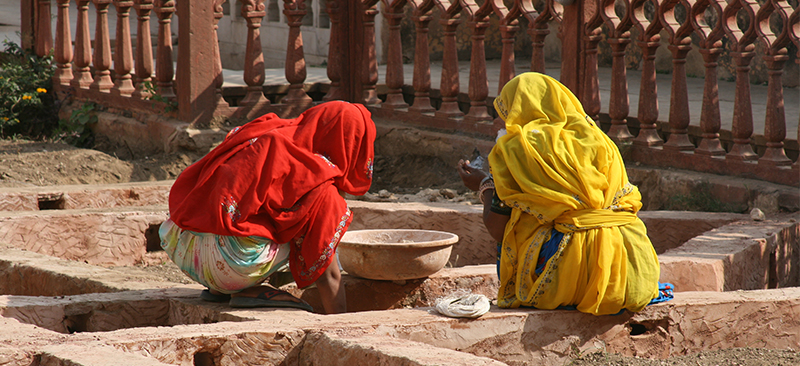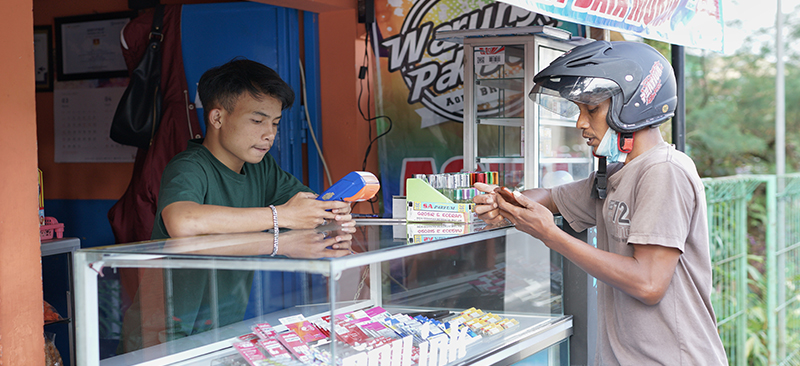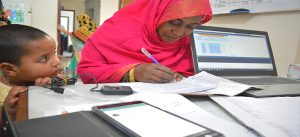This policy brief highlights the key findings from an assessment of unconditional cash transfers in food subsidies in three union territories in India. It also contains recommendations for the food subsidy program in India. The note recommends the Indian government to allow the beneficiaries to take rations from any fair price shop in the country and diversify the beneficiary food basket; focus on improving nutritional literacy; and strengthen the value chain of food subsidy delivery
Blog
Five ways in which the pandemic hit women and girls the hardest
Two deadly waves of the pandemic destroyed countless lives and livelihoods across India. Even before the pandemic, the country’s progress toward gender parity was uneven. COVID-19 took a heavier economic toll on women and girls. Ground reports and public data indicate that the urgency of dealing with COVID-19 has diverted the focus away from serious issues women face. This publication uses public data to explore these issues, such as a rise in attempts at child marriage, trafficking, a fall in institutional deliveries, loss of livelihoods, and a rise in unpaid care work and domestic violence.
Strengthening the digital ecosystem: Expanding the adoption of Quick Response Code Indonesian Standard (QRIS) among MSMEs in Indonesia
“The application process is just too complicated, and I struggle to explain it to my customers.”
– A female QRIS merchant in an urban area
One of the key pillars of a booming digital economy is a low-cost and inclusive payments infrastructure. Countries like Brazil, India, and Bangladesh have launched their respective interoperable payment solutions based on the quick response (QR) code to bring small businesses into the digital payments ecosystem. These initiatives have yielded positive outcomes and helped policymakers scale up digital payments from small and micro-enterprises, a segment that forms the backbone of any developing economy.
Indonesia, too, has adopted a similar path and made rapid progress in implementing an interoperable payment system based on QR code
In 2019, Bank Indonesia launched the Quick Response Indonesian Standard (QRIS) solution as part of its payment system vision for 2025. QRIS establishes uniform QR standards to encourage Indonesia’s 65 million MSMEs to adopt cashless payments, with the ultimate objective of universal cashless payments.
With the introduction of the QRIS solution, Bank Indonesia also fixed the Merchant Discount Rate (MDR)[1] at 0.7%—a major improvement from the previous practice of determining MDR through negotiations between individual merchants and service providers.
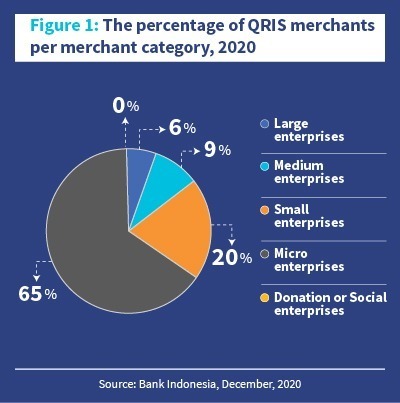
Within a year of its launch, QRIS merchant sign-ups in Indonesia have seen massive growth. As of 2020, 5.3 million merchants had signed up for QRIS. MSMEs contributed to 80% of these sign-ups. Figure 1 depicts the breakup of these merchants according to their category.
While microenterprises account for the highest number of sign-ups of the QRIS solution so far—small, medium, and large enterprises registered much higher growth in terms of overall sign-ups for the solution (as shown in Figure 2). This trend may reflect the higher levels of awareness and digital capacities of SMEs. Moreover, the customer base of SMEs comprises more individuals from the low- and middle-income segments in urban geographies These customers already use mobile-based payment likely to adopt alternative channels.

Despite a remarkable growth in the number of merchant sign-ups, the adoption rate of QRIS-enabled payments remains low
Our recent study on CICO agents in Indonesia shows that an active QRIS merchant performs around 14-17 transactions per month. However, data released by Bank Indonesia suggests that, on average, a QRIS merchant conducts about three transactions per month. Anecdotal evidence indicates that a large majority of merchants remain dormant.
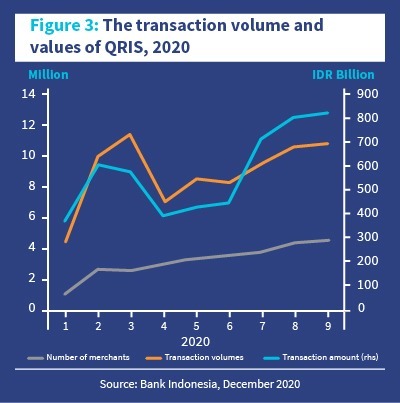
What are the reasons for the low adoption of QRIS among MSMEs in Indonesia?
Lack of awareness and low digital literacy
Dalberg’s multi-country study on small merchants highlights that in countries that digitalized their payment landscape , merchants who reported having insufficient information were less likely to use digital payments. This also holds true in the case of Indonesia. MSC’s MSME study shows that 65% of MSMEs were not aware of the QRIS solution, and only 4% of them used it for their business. Further, our recent study revealed that most micro-enterprises in Indonesia have limited access and capacities to conduct digital transactions, such as QRIS. People in non-metro locations and from low-income segments need more time to adopt QRIS. Moreover, qualitative data from our study suggests that the support staff of financial service providers (FSPs) shared little to no information on QRIS with merchants. A possible reason for this is the lack of incentives for FSPs to promote QRIS—due to the interoperability of QRIS, any FSP can push its service to a merchant regardless of who onboarded the merchant to QRIS.
Lack of value proposition
A study by Dalberg revealed that micro and small merchants prefer to pay their suppliers and employees in cash and experience little or no demand for digital payments from their customers. Our study reinforces this finding—68% of MSMEs in Indonesia did not use any medium for digital payments, such as QRIS to accept payments from customers since the pandemic started. MSMEs claim that their customers do not use the digital payment solution, which makes QRIS payments irrelevant for them. Insights from DataReportal support this claim—while nearly half of the country’s population has an account with a financial institution, only 3.1% of Indonesians have a mobile money account. People who use e-money accounts are primarily youth who reside in urban centers and use mobile money for ride-hailing and e-commerce payments. The penetration of e-money remains limited in peri-urban and rural areas.
A complicated sign-up process and lack of provider support
In our MSME study, 17% of merchants reported that they find the QRIS sign-up process too complicated. For instance, merchants need to provide numerous details during onboarding. This makes the process cumbersome and overwhelming, especially since providers lack field staff to assist merchants. Moreover, the process is prone to errors. Even a slight difference in the name of a merchant’s shop can also lead to the issuance of a different QR code. Several merchants reported that they received little support from their providers to resolve queries on operational processes, such as transactions, settlement, and customer grievances.
Sensitivity to Merchant Discount Rate (MDR) charges and fear of disclosing revenues to taxation authorities
The perception of merchants about the impact of QRIS on their manner of doing business affects their decision to embrace the payment solution strongly. Similar to other geographies, merchants in Indonesia are sensitive to transaction charges . Despite Bank Indonesia’s efforts to reduce charges and waive MDR for QRIS, merchants still hesitate to pay for the solution and fear that MDR would eventually dent their thin margins. Moreover, merchants perceive that the potential increase in digital transactions could make their revenues more transparent and traceable for authorities, which would subject them to further taxation.
The way forward: Steps to improve the adoption and uptake of QRIS-based transactions in Indonesia
Increase awareness and enhance digital capacities among MSMEs
The government and financial service providers (FSP) must focus their campaign and training efforts on areas that have a higher penetration of mobile banking and e-wallets, and target merchants who show higher potential and willingness to offer digital payments. MSC’s merchant segmentation framework can help achieve this objective. FSPs need to determine opinion leaders among merchants who can be positioned to educate, motivate, and assist customers during their “teachable moments,” such as instances when customers use QRIS. These opinion leaders can influence other merchants and customers within their communities. The government must equip the targeted micro-enterprises with sufficient knowledge of QRIS, encourage them to gain first-hand experience with the solution, and help them build confidence, trust, and awareness. Training initiatives similar to Gojek’s Wirausaha program, conducted in a workshop setting with audio-visual tutorials and live demonstrations on QRIS can help MSMEs understand its processes and benefits better. The government needs to collaborate with the private sector to enhance awareness of digital solutions, especially in peri-urban areas around big cities.
Enhance the value proposition for QRIS payments
QRIS solutions are traditionally enabled through the merchant presented mode (MPM) or customer presented mode (CPM), which require physical transactions at the merchant point. However, with the risks associated with physical transactions during a pandemic, QRIS needs alternatives to face-to-face transactions that allow merchants and customers to send QRIS payment codes over online channels. This would offer a value proposition on par with bank transfers, the primary digital payment option used by most SMEs. China has expanded the use of QR payment by promoting the use of social QR codes to gift “red envelopes”[2] during the Chinese New Year.
Increase the potential use-cases and value creation for QRIS
FSPs and policymakers should move beyond cashback and person-to-business use-cases of QRIS, such as bill payments, and assess the potential demand for digital payments to realize the full potential of QRIS as a digital solution. The government can provide an option of contactless authentication for government-to-person (G2P) initiatives, such as social payments. For instance, countries like Bangladesh, China, and Thailand opted for digitalization to enable safe and cheap transactions at the height of the pandemic. Moreover, the government can also use QRIS to encourage person-to-government (P2G) payments, like India used its BHIM UPI QR code to accept donations under the PM CARES Fund.
The government must also consider providing incentives, both for FSPs and merchants, to drive the uptake of QRIS. It can learn from the example of India, which has allocated funds to provide incentives to promote digital payments. In Singapore, hawkers who sign up for SGQR are eligible for a monthly bonus under its Hawkers Go Digital Program. Moreover, Bank Indonesia must continue to waive the MDR, especially in the initial phase of the implementation of QRIS to make it more attractive among merchants.
Simplify the sign-up process for merchants and provide better support
FSPs must make QRIS easier to use for merchants and help them gain and sustain confidence. FSPs should establish fully digital sign-up options similar to the Faspay and DOKU registration facilities so that merchants do not miss out on regular business during the sign-up process. They must also provide support to merchants. FSPs can learn from the example of Singapore’s “digital ambassadors” who help stallholders set up the SGQR code and application on their mobile phones during sign-up.
Conclusion
QR codes have helped countries bring a range of excluded segments, such as MSMEs into their digital payments ecosystem. As Indonesia continues to expand QRIS to 12 million MSMEs and support its national economic recovery program, it will need to continue collaborations and introduce targeted interventions. Further research to understand and address the finer nuances of challenges that the demand and supply sides face in adopting and implementing QRIS is crucial to get full support from all stakeholders and reach the potential of the initiative. As the adoption of QRIS accelerates, policymakers and regulators will also need to focus on ensuring data privacy and enhancing consumer protection.
[1] The cost incurred by merchants for payment processing services
[2] Red envelopes or red packets are a long-standing fixture of Chinese New Year celebrations wherby adults usually gift money to young relatives.
The disruptors get disrupted: Indian FinTechs during COVID-19
This blog is a part of a COVID-19 research study conducted under the Financial Inclusion Lab accelerator program. The lab receives support from some of the largest philanthropic organizations across the world, including the Bill & Melinda Gates Foundation, J.P. Morgan, Michael & Susan Dell Foundation, MetLife Foundation, and Omidyar Network.
The Indian FinTech market grew by 20% between 2017 to 2021, and is currently valued at USD 50-60 billion (INR 3.7-4.4 trillion). FinTechs have played a pivotal role in transforming the Indian economy in the past decade. Their digital and tech-based solutions have overhauled the financial services industry and driven financial inclusion. The onset of COVID-19 in 2020 affected the growth of these FinTechs—some of them thrived, while others struggled. Many FinTechs found it challenging to interact with prospective users, investors, or active customers in the field due to lockdowns and social distancing mandates. Despite these obstacles, the valuation of FinTechs in India could rise to USD 150 billion (INR 11.1 trillion) by 2025 with appropriate investments, regulatory policies, and customer usage.
COVID-19 and its impact on the Indian FinTech ecosystem
The pandemic has been a double-edged sword for the Indian FinTech ecosystem. While substantial investments nourished some FinTech businesses, others struggled to stay afloat with limited resources at hand. The following infographic depicts the major areas of impact for FinTechs, as detailed in our recent report.

Figure 1: Major areas of impact on FinTechs
A surge in savings boosted the growth of wealth-management FinTechs
Uncertainties during the pandemic affected the financial stability of low- and middle-income (LMI) Indians—the unemployment rate shot up as work became irregular and salaries insecure. The lack of a safety net pushed the LMI segment further to the brink. As interest in deposit products increased, the younger generation looked for new avenues to park their savings with a focus on flexibility and minimal procedures. The increase in awareness around savings enabled saving- and investment-based FinTechs to realize higher revenues. Buoyed by the change in customer behavior, funding in this sector of FinTechs saw an upward trend.
Liquidity crunch for credit FinTechs
Amid multiple lockdowns and economic instability, the incomes of retail customers and small businesses dropped, which made it challenging for these borrowers to repay loans. The moratorium announced by the Reserve Bank of India and an increase in delinquencies lowered the revenues of credit FinTechs, and some of them had to shut shop. This also affected investor sentiment—they became more cautious and focused on larger FinTechs with sustainable and proven business models.
Expansion of InsurTechs due to the jump in demand
The demand for insurance solutions leaped as customers sought more insurance cover, yet preferred entirely digital policies to reduce the risk of infection. InsurTechs launched products customized to COVID-19 to capitalize on this massive demand for pandemic-related health covers. They deployed data and analytics to craft customer-friendly, bite-sized solutions that became popular in 2021. Funding deals from investors also increased due to this pandemic-led growth in insurance penetration.
Multifold growth for digital payment FinTechs
The growth of digital payments accelerated in 2020 and 2021, as more people switched to contactless modes of transactions. UPI-based transactions shot up by 71% year-on-year in December, 2020, with the three largest players—PhonePe, Google Pay, and Paytm—commanding more than 90% of the market share. This growth of payment FinTechs symbolizes the new normal in India, where digital transactions have been replacing cash-based payments rapidly. As several mature payment FinTechs attracted strategic investments, their focus remained on enhancing the product experience with digital transformation.
How FinTechs coped with the challenge of COVID-19
Most FinTechs across various sub-sectors used the crisis to re-think and re-emerge with better business strategies. While the business model and customer segment influenced their recovery strategies significantly, we noticed five consistent strategies that FinTechs used to survive and sustain in the new normal – see Figure 2.

Figure 2: Coping strategies of FinTechs
FinTechs have made enhanced their digital engagement. For example, many FinTechs now use remote communication tools to interact with stakeholders, such as employees and investors, and WhatsApp or SMS-based messaging for customers. Though customer lifecycles are largely digital, most platforms look to digitize them further. As our study observed, customers now prefer using digital channels to interact with platforms due to the convenience and promptness of these solutions. FinTechs have adapted to this change by replacing field-based customer touchpoints with virtual support assistants on their platforms, to enhance customer experience and streamline their operations.
With the shift in customer behavior, FinTechs have also diversified their product range to attract new customer segments. Platforms have begun to offer products that are customizable at the user’s end for wider outreach and made their platforms more inclusive. Some InsurTechs now offer “bite-sized” insurance products at USD 5.4 (INR 396) per year. Similarly, credit FinTechs pushed the idea of “buy now pay later” for digital transactions.
While designing new products, FinTechs have been using data to deliver customer solutions more efficiently. They use multiple data points and intricate algorithms to determine the financial behavior of their customers. Some credit FinTechs even use psychometric analysis to identify repayment behaviors of prospective borrowers.
Dedicated efforts along with the ability to adapt and innovate in these difficult times have positioned FinTechs well to tackle new challenges.
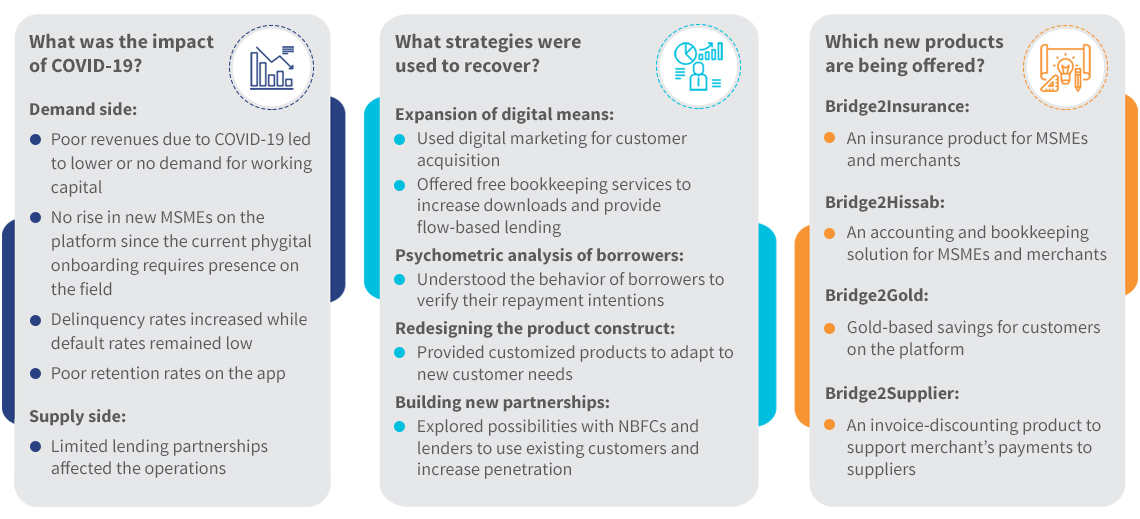
Figure 3: A snapshot of Bridge2Capital, a FinTech case study in our report
Supporting FinTechs for a brighter future
FinTechs have come a long way since the pandemic struck, but they still need the support of stakeholders in the ecosystem to continue to grow. Even as existing FinTechs struggled to adapt to the new normal, new ones were set up to address the needs of various customer segments. Though such FinTechs are well-oriented to serve customers through their digital platforms, they struggle with market knowledge, logistics support, and funding. These FinTechs, in particular, need support from regulators, accelerators, and investors to help them reach customers and deliver services. Here are a few recommendations for stakeholders to support the growth of FinTechs, as detailed in our report.
Ease regulations and compliances: As per our study, FinTechs struggle with regulatory requirements and processes. This is mostly due to a lack of clarity in the public domain on how government regulations affect organizations, and how they can furnish the required information to regulators. In the age of digital solutions, FinTechs still need paper-heavy processes to start their businesses and face procedural hindrances. We still see the prevalence of archaic systems such as sending cancelled cheques to regulators at the time of registering a business, as well as long wait times on hearing back from authorities.
Improve the dissemination of information on policies: Most start-ups lack clarity on how to apply for stimulus packages from the government. Policymakers should clearly communicate the procedure and eligibility requirements for availing micro, small, and medium enterprise (MSME) stimulus packages on official websites and social media channels. This will clear up existing confusion and reduce the time for FinTechs to receive grants and stimulus packages.
Prime and accelerate FinTechs for the future: FinTechs need guidance on marketing, customer and business strategies, and business management planning. Most first-time FinTech founders are young and need support to scale up operations. COVID-19 has aggravated this existing challenge. Accelerators should help create a comprehensive understanding of current market trends and changes in the ecosystem to support start-ups.
Though 2020 presented many challenges for FinTechs, it also taught them valuable lessons. Most FinTechs struggled to adapt, and not all of them survived. The newfound stability of organizations that managed to find their feet will last well into the subsequent waves of the pandemic. Their understanding of the new market climate will help them engage new customer segments and address gaps across the market. 2021 has already started to witness increased interest from national and international investors, which is a positive sign for the FinTech ecosystem. The period between the first and second waves of the pandemic has helped FinTechs observe market and customer trends, and prepare their business plans accordingly.
As 2021 progresses, we expect new products that address the needs of consumers to enter the market. Addressing the unique needs of niche segments as well as increasing convenience, FinTechs are revolutionizing the way Indians access financial services and driving financial inclusion. Though the pandemic disrupted some of their plans, these disruptors are here to stay and grow. As FinTechs recover from the impact of the second wave, we look forward to positive changes in the coming months.
Impact of COVID-19 on FinTechs: India
COVID-19 has affected millions of lives and livelihoods across the globe. India’s experience with the pandemic has been particularly painful. MSC conducted a three-phase study to understand and assess the impact of the pandemic on the FinTech ecosystem. Our initial report presented the impact of COVID-19 on Indian FinTechs and various strategies that helped them survive and recover. This report shines a light on how the FinTech ecosystem has progressed and adapted to the new normal.
Impact of COVID-19 on Fintech: Bangladesh
Bangladesh managed to contain COVID-19 swiftly. Consequently, the pandemic barely affected some FinTechs while others, such as e-commerce, online essential item delivery firms, and payment wallets, even thrived because of it. However, early-stage start-ups struggled as they depend heavily on access to banks and investors for funding, which has been scarce during these times.
This report presents the impact of the pandemic on the operations, revenue, and coping strategies of FinTechs in Bangladesh. It also explores the investor sentiment and impact of government policies on the development of FinTechs. The report further provides recommendations for relevant stakeholders to help affected FinTechs recover.

